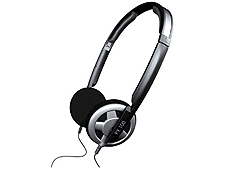


How would you feel about an audiophilically-acceptable product for use on the move that costs under £30? With style and wit, Sennheisercleverly packaged its PX 100 headphone in a rugged plastic holder the shape and size (145x75x27mm) of a sunglasses case. The only criticism is the failure to provide it with a belt-clip or other means of attaching it to one's clothing. That aside, it's perfect for slipping into a flight- or sports-bag along with one's portable CD player or - more increasingly - a notebook computer or MP3 player, with total confidence that it will still be in one piece when you retrieve it.
Out of the holder, the PX 100 looks and feels like a set of 'real' headphones, the folding act being a clever arrangement in which the earpieces swivel to a flat position, within the collapsible metal headband and its interlocking sections. Slide the folded headphones into the case, wrap the 1.4m Kevlar-reinforced oxygen-free cable (with 3.5mm plug) around the groove encircling the case, snap it shut, and your PX 100s are as safe as houses.
An open-back design, the PX 100 uses low-mass diaphragms with spiral embossing, and neodymium magnets in lightweight housings based on HD 414 technology. The foam on-the-ear cushions are 50mm in diameter, and the 60 weight and the pressure from the padded headband didn't bother this eyeglass wearer. Specs-wise, the PX 100 is rated at 32 ohms, the frequency response is 15-27kHz, THD is less than 0.1 percent and maximum SPLs a worrying 114dB.
It was instantly apparent that the sound was nothing short of superb, with plenty of bass, a fine, relatively out-of-head spatial effect and absolute freedom from treble nasties. But I didn't get their true measure until I auditioned it with SACDs through Sony's XA-333ES player with headphone socket and separate volume control.
Downsides? The PX 100 errs on the side of euphony, so they may be lacking in the precision and detail you'd find in sealed-back, studio-type headphones, and sound leakage in both directions is a fact of life with open designs. For £10 more, however, you can buy the PX 200 with sealed-back capsules. The main spec change is an extra 5Hz down below, but a top end of 21kHz, and an extra 1dB of maximum SPLs.
Read More on Page 2
If you're an inveterate portable user, the PX 100 will make your day by enhancing your listening pleasure...which is all we ask of audio products. At 29.95, the PX 100 is a little miracle and an indisputable bargain.Out of the holder, the PX 100 looks and feels like a set of 'real' headphones, the folding act being a clever arrangement in which the earpieces swivel to a flat position, within the collapsible metal headband and its interlocking sections. Slide the folded headphones into the case, wrap the 1.4m Kevlar-reinforced oxygen-free cable (with 3.5mm plug) around the groove encircling the case, snap it shut, and your PX 100s are as safe as houses.
An open-back design, the PX 100 uses low-mass diaphragms with spiral embossing, and neodymium magnets in lightweight housings based on HD 414 technology. The foam on-the-ear cushions are 50mm in diameter, and the 60 weight and the pressure from the padded headband didn't bother this eyeglass wearer. Specs-wise, the PX 100 is rated at 32 ohms, the frequency response is 15-27kHz, THD is less than 0.1 percent and maximum SPLs a worrying 114dB.
It was instantly apparent that the sound was nothing short of superb, with plenty of bass, a fine, relatively out-of-head spatial effect and absolute freedom from treble nasties. But I didn't get their true measure until I auditioned it with SACDs through Sony's XA-333ES player with headphone socket and separate volume control.
Downsides? The PX 100 errs on the side of euphony, so they may be lacking in the precision and detail you'd find in sealed-back, studio-type headphones, and sound leakage in both directions is a fact of life with open designs. For 10 more, however, you can buy the PX 200 with sealed-back capsules. The main spec change is an extra 5Hz down below, but a top end of 21kHz, and an extra 1dB of maximum SPLs.
If you're an inveterate portable user, the PX 100 will make your day by enhancing your listening pleasure...which is all we ask of audio products. At 29.95, the PX 100 is a little miracle and an indisputable bargain.